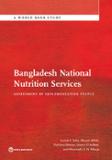Bangladesh national nutrition services: assessment of implementation status
 This report presents the findings of an operations research study conducted to assess the implementation of the Government of Bangladesh’s National Nutrition Services Program (NNS) and to identify the achievements, determine the bottlenecks that adversely impact these achievements, and highlight potential solutions to ensure smooth delivery of the program. A mixed methods research approach was used to evaluate five major domains of the program: management and support services; training and capacity development; service delivery; monitoring and evaluation, and; exposure to interventions. The study found that the overall NNS effort is an ambitious, but valuable approach to support nutrition actions through an existing health system with diverse platforms. The results indicate that although the maintenance of strong and stable leadership of NNS is an essential element to ensure integrated and well-coordinated comprehensive service delivery for the line directorate, the current arrangement is unable to ensure effective implementation and coordination of NNS. Focusing on some of the critical challenges related to leadership and coordination in the first instance, and on embedding a small core set of interventions into well-matched (for scale, target populations, and potential for impact) health system delivery platforms is most likely to help achieve scale and impact. Strategic investments in ensuring transparency, engaging available technical partners for monitoring and implementation support, and not shying away from other potential high coverage outreach platforms like some NGO platforms also could prove fruitful. Moreover, although the Government of Bangladesh, and the health system in particular, must lead the effort to deliver for nutrition, it is clear that development partners who have expressed a commitment to nutrition must coordinate their own activities and provide the support that can deliver on nutrition’s potential for Bangladesh.
This report presents the findings of an operations research study conducted to assess the implementation of the Government of Bangladesh’s National Nutrition Services Program (NNS) and to identify the achievements, determine the bottlenecks that adversely impact these achievements, and highlight potential solutions to ensure smooth delivery of the program. A mixed methods research approach was used to evaluate five major domains of the program: management and support services; training and capacity development; service delivery; monitoring and evaluation, and; exposure to interventions. The study found that the overall NNS effort is an ambitious, but valuable approach to support nutrition actions through an existing health system with diverse platforms. The results indicate that although the maintenance of strong and stable leadership of NNS is an essential element to ensure integrated and well-coordinated comprehensive service delivery for the line directorate, the current arrangement is unable to ensure effective implementation and coordination of NNS. Focusing on some of the critical challenges related to leadership and coordination in the first instance, and on embedding a small core set of interventions into well-matched (for scale, target populations, and potential for impact) health system delivery platforms is most likely to help achieve scale and impact. Strategic investments in ensuring transparency, engaging available technical partners for monitoring and implementation support, and not shying away from other potential high coverage outreach platforms like some NGO platforms also could prove fruitful. Moreover, although the Government of Bangladesh, and the health system in particular, must lead the effort to deliver for nutrition, it is clear that development partners who have expressed a commitment to nutrition must coordinate their own activities and provide the support that can deliver on nutrition’s potential for Bangladesh.
